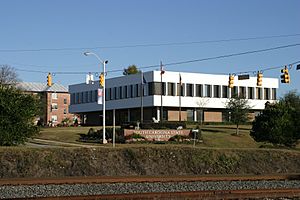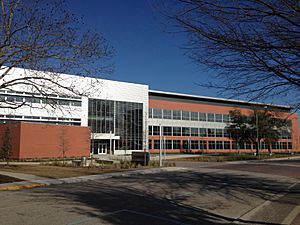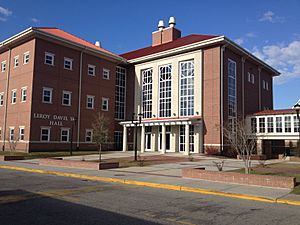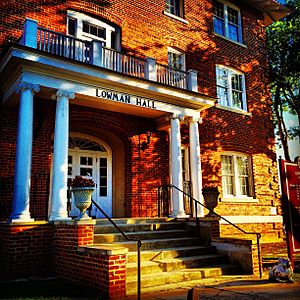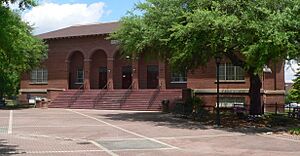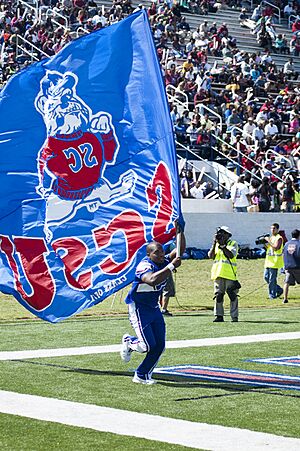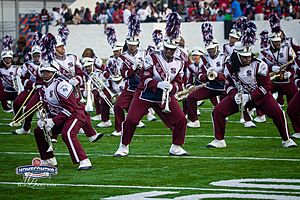South Carolina State University facts for kids
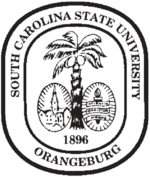 |
|
|
Former name
|
Colored Normal Industrial Agricultural and Mechanical College of South Carolina (1896–1954) South Carolina State College (1954–1992) |
|---|---|
| Motto | Scientia, Officium, Honos |
|
Motto in English
|
Knowledge, Duty, Honor |
| Type | Public university HBCU Land-grant university |
| Established | March 4, 1896 |
| Accreditation | SACS |
| Endowment | $17.2 million (2023) |
| President | Alexander Conyers |
| Students | 2,649 |
| Undergraduates | 2,374 |
| Postgraduates | 275 |
| Location |
,
United States
33°29′50″N 80°51′00″W / 33.49722°N 80.85000°W |
| Campus | 447 acres (181 ha), (160 acres (65 ha) at Orangeburg campus, 287 acres (116 ha) additional acres at Camp Harry Daniels in Elloree, South Carolina) |
| Colors | Garnet and blue |
| Nickname | Bulldogs and Lady Bulldogs |
|
Sporting affiliations
|
NCAA Division I – MEAC |
 |
|
South Carolina State University (often called SCSU or SC State) is a public university in Orangeburg, South Carolina. It is a special kind of school called a Historically Black College and University (HBCU). This means it was first created to provide higher education for African American students. It is also a land-grant university, which means it received land from the government to focus on teaching agriculture and mechanical arts.
SC State is the only public HBCU in South Carolina that is also a land-grant research university. It is part of the Thurgood Marshall College Fund, which supports public HBCUs. The university is also officially approved by the Southern Association of Colleges and Schools (SACS), which means its programs meet high quality standards.
Contents
University History
The university started in 1872 as the South Carolina Agricultural and Mechanical Institute. It was part of Claflin College, which is now Claflin University. This was done to follow the 1862 Land Grant Act.
In 1896, the state of South Carolina decided to create a separate school. It was named the Colored Normal Industrial Agricultural and Mechanical College of South Carolina. This was its official name until 1954.
Growth in the 1920s–1940s
During this time, the school focused more on its academic programs. The number of students grew. However, some programs, like the university's high school, had to close. This was because of the Great Depression, a time when money was very scarce. New government programs helped build Wilkinson Hall. This was the university's first separate library building. Today, it holds the Admissions and Financial Aid offices.
Changes in the 1940s–1950s
The college campus got bigger. It bought over 150 acres (61 ha) for students to learn about farming. After World War II, many students came to the college. This caused a shortage of classrooms. In 1947, the United States Army started an ROTC program here. All male students had to join until 1969.
The school's name also changed in 1954 to South Carolina State College. Because of "separate but equal" laws at the time, the state gave the college a lot of money. This money was used to build new classrooms and dorms. Some of these buildings, like the Student Union (1954) and Turner Hall (1956), are still used today. This was done to try and give Black students an "equal" education. The state also created a law program at the college. This was mainly to stop Black students from going to the law school at the then-segregated University of South Carolina. The law program at SC State closed in 1966 after the University of South Carolina allowed all students.
The 1960s–1980s Era
During the Civil Rights Movement, many students at SC State took part in protests. They wanted to end segregation, which was the separation of people based on race. A very sad event happened on February 8, 1968. Three students were killed and 27 others were hurt by state police. This happened during a protest against a segregated bowling alley nearby. This tragedy is known as the Orangeburg massacre. A special memorial plaza on campus remembers this event.
From the late 1960s to the mid-1980s, the campus grew a lot. This happened under the leadership of M. Maceo Nance. Many new academic buildings were built, like Nance Hall (1974) and Belcher Hall (1986). New dorms were also added, such as Sojourner Truth Hall (1972). This dorm is 14 stories tall and is the tallest building in Orangeburg County. A new library building opened in 1968. Many existing buildings were also made larger and updated. The school also opened the I.P. Stanback Museum & Planetarium. This is the only facility of its kind at an HBCU in the United States. After Nance retired in 1986, Albert Smith became president. He created an honors college in 1988.
The 1990s Era
During Albert Smith's time as president, the school became a university. The South Carolina General Assembly gave it university status in February 1992. It was then named South Carolina State University. In 1993, Barbara Hatton became the first female president of the school. She made many improvements to the campus. For example, in 1994, Oliver C. Dawson Bulldog Stadium was updated. New suites and a larger press box were added, and its seating capacity grew to 22,000. Hatton also led the creation of a plaza in front of the Student Union. This plaza goes past several dorms and buildings in the middle of the campus.
Under the next president, Leroy Davis, South Carolina State University celebrated its 100th anniversary in 1996. The school also built a Fine Arts Center in 1999. This gave the Art and Music departments a new home.
The 2000s to Present
Under the leadership of Andrew Hugine Jr., the school built a new dorm called Hugine Suites. It has 771 beds and is the largest dorm in South Carolina. The first buildings opened in August 2006. With these new dorms, some older ones were closed. These included Bethea, Miller, Bradham, and Manning Halls. Bethea Hall was later torn down to make space for a new building for the School of Engineering.
The dining halls, Washington Dining Hall and "The Pitt," were also updated. The dining hall inside Truth Hall was changed into a cyber cafe called Pete's Arena. The university also worked to update Lowman Hall. This building became the new administration building. South Carolina State also started building the new James E. Clyburn University Transportation Center (UTC). This center is the only UTC in South Carolina. It is one of only three among Historically Black Colleges and Universities (HBCUs). Work was also done to make Hodge Hall, a science building, larger. It gained much-needed research and laboratory space.
South Carolina State hosted the first debate for the 2008 Democratic Party Presidential Candidates. This event happened on April 26, 2007, at the Martin Luther King Auditorium. It was shown on national television by MSNBC. This made SC State the first historically black university to host a presidential candidate debate on its campus.
In 2021, President Joe Biden visited Orangeburg. He gave a speech at South Carolina State's graduation ceremony.
University Academics
The university offers many academic programs. These programs are organized into four colleges and one school:
- College of Education, Humanities, and Social Sciences
- College of Graduate and Professional Studies
- College of Science, Mathematics, and Engineering Technology
- Dr. Emily England Clyburn Honors College
- School of Business
Nuclear Engineering Program
SCSU is the only university in South Carolina that offers a bachelor's degree in nuclear engineering. It is also the only HBCU in the country with this program. The program is approved by ABET, which sets standards for engineering education. It works closely with North Carolina State University and University of Wisconsin-Madison.
Accreditation and Rankings
South Carolina State is officially approved by the Southern Association of Colleges and Schools (SACS). This means its education programs meet high standards. In 2023, U.S. News & World Report ranked SC State among the top regional universities in the South. It was also ranked highly among HBCUs.
Campus Life
The main campus of South Carolina State University is 160 acres (65 ha) large. There are also an additional 267 acres (108 ha) at Camp Harry Daniels in Elloree, South Carolina. Three buildings on campus are listed on the National Register of Historic Places. These are Lowman Hall, Hodge Hall, and Dukes Gymnasium.
The university's library is called the Miller F. Whittaker Library. It was built with $1 million from the state in 1967 and opened in 1969. The library is named after the university's third president. It originally had two levels, and a third level was added in 1979.
University Athletics
South Carolina State is a founding member of the Mid-Eastern Athletic Conference (MEAC). Its sports teams compete in NCAA Division I. For college football, they play in the FCS. The school has teams for basketball, soccer, volleyball, softball, cross country, track and field, and tennis for women. For men, they have teams for basketball, tennis, track and field, cross country, and football. The teams are called the Bulldogs or Lady Bulldogs. The school colors are garnet and navy blue.
The school's football team has won more conference championships than any other team in the MEAC, with 19 titles. Three former Bulldogs football players are in the College Football Hall of Fame, including coach Willie Jeffries. The team has also won six Black college football national championship titles. Their most recent title was in 2021.
Student Organizations
There are over 50 different student groups and clubs on campus.
The Marching 101 Band
The university's marching band is famous and known as The Marching 101. The band often performs at football games across the southeastern United States. They have also performed at professional football games shown on TV. They have even marched in The Macy's Thanksgiving Day Parade and The Rose Bowl Parade. The band started in 1918 as a "regimental band." It performed military drills and helped with music for college events.
The band got its nickname "Marching 101" because it started with 100 members and 1 majorette. Today, the band has over 150 members. They are joined by a majorette team called "Champagne." The Marching 101 has been chosen to perform at the annual Honda Battle of the Bands in Atlanta several times.
Famous Alumni
Many successful people have graduated from South Carolina State University.
Academia and Research
| Name | Graduation Year | What They Are Known For | Reference(s) |
|---|---|---|---|
| Kandice Tanner | 2002 | A top researcher at the National Cancer Institute. |
Business Leaders
| Name | Class year | Notability | |
|---|---|---|---|
| Richard G. Shaw | First African-American to be Insurance Commissioner in West Virginia. |
Educators
| Name | Class year | Notability | |
|---|---|---|---|
| Essie Mae Washington-Williams | 1946 | An educator and the African-American daughter of former U.S. Senator Strom Thurmond. | |
| Andrew Hugine, Jr. | 1971, 1974 | Former President of S.C. State (2003–2008); Current President of Alabama A & M University. | |
| M. Christopher Brown II | 1993 | Current President of Kentucky State University and former President of Alcorn State University. | |
| Benjamin F. Payton | 1955 | Former President of Tuskegee University. | |
| George Bradley | 1983 | Former President of Paine College. | |
| Anthony Parker | 1975 | President of Albany Technical College. | |
| John H. Dozier | 1993 | Current President of Columbia College (South Carolina). |
Arts and Media
| Name | Class year | Notability | |
|---|---|---|---|
| Doris Funnye Innis | 1955 | Writer, journalist, educator, and editor for civil rights publications. | |
| Horace Ott | Pianist, composer, conductor, and record producer. | ||
| Ron Westray | Jazz trombonist, composer, and educator. | ||
| Armstrong Williams | 1981 | Political columnist for radio, TV, and newspapers. | |
| Charlton Singleton | 1994 | Music educator, conductor, and a founding member of the Grammy Award-winning group Ranky Tanky. | |
| Kára McCullough | 2013 | Miss District of Columbia USA 2017 and Miss USA 2017. |
Politics, Law, and Government
| Name | Class year | Notability | |
|---|---|---|---|
| Juanita Goggins | The first African-American woman elected to the South Carolina legislature. | ||
| James E. Clyburn | 1961 | U.S. Representative from South Carolina (1993–present) and former Majority Whip in the United States Congress. | |
| Ernest A. Finney, Jr. | JD, 1954 | The first African-American Supreme Court Justice appointed to the South Carolina Supreme Court since the Reconstruction Era. | |
| Matthew J. Perry | 1948,1951 | A United States Federal Judge. | |
| Clifford L. Stanley | 1969 | U.S. Under Secretary of Defense for Personnel and Readiness. | |
| John W. Matthews, Jr. | South Carolina State Senate member. |
Military Leaders
| Name | Class year | Notability | |
|---|---|---|---|
| Amos M. Gailliard Jr. | 1951 | Retired Brigadier General in the New York Guard. | |
| Abraham J. Turner | 1976 | Retired Major General in the United States Army. | |
| Stephen Twitty | 1985 | Retired Lieutenant General in the United States Army. | |
| Henry Doctor Jr. | 1954 | Retired Lieutenant General in the United States Army. |
Sports Stars
| Name | Class year | Notability | |
|---|---|---|---|
| Bobby Lewis | 1968 | Point guard and creator of the Two Ball Skills Development Program. | |
| Javon Hargrave | 2016 | NFL nose tackle. | |
| Willie Jeffries | 1959 | Legendary college football coach. He was the first African-American coach of a Division I majority white school. | |
| Deacon Jones | Former professional football player for the Los Angeles Rams, San Diego Chargers, and Washington Redskins; inducted into the Pro Football Hall of Fame in 1980. | ||
| Phillip Adams | 2010 | NFL defensive back. | |
| Joe Ikhinmwin | 2012 | Former professional basketball player and team captain of London Lions (basketball). | |
| Willie Aikens | Former Major League Baseball player. | ||
| Rickey Anderson | Former National Football League running back. | ||
| Orlando Brown | Former professional football player for Cleveland Browns and Baltimore Ravens. | ||
| Rafael Bush | 2010 | Former NFL defensive back. | |
| Barney Bussey | 1984 | Former NFL defensive back. | |
| Kenny Bynum | Former National Football League running back. | ||
| Harry Carson | Former professional football player for the New York Giants; inducted into the Pro Football Hall of Fame in 2006. | ||
| Edwin Bailey | 1980 | Former NFL guard for the Seattle Seahawks. | |
| Rufus Bess | 1978 | Former professional football player for the Minnesota Vikings. | |
| Charlie Brown | 1981 | Former professional football player for the Washington Redskins. | |
| Barney Chavous | 1973 | Former NFL defensive end. | |
| Dextor Clinkscale | 1979 | Former National Football League safety for the Dallas Cowboys. | |
| Chartric Darby | Professional football player for Tampa Bay Buccaneers and Seattle Seahawks. | ||
| Will Ford | Professional football player in the Canadian Football League. | ||
| John Gilliam | 1966 | Former professional football player for the St. Louis Cardinals, New Orleans Saints and Minnesota Vikings. | |
| Darius Hadley | Former professional football player in the Arena Football League. | ||
| Dwayne Harper | 1987 | Former professional football player for the Seattle Seahawks. | |
| LaKendrick Jones | Former football player in the Arena Football League. | ||
| William Judson | 1981 | Former professional football player for the Miami Dolphins. | |
| Angelo King | 1980 | Former professional football player for the Dallas Cowboys. | |
| James Lee | Professional football player for the Tampa Bay Buccaneers. | ||
| Shaquille Leonard | 2017 | NFL linebacker for the Indianapolis Colts. | |
| Marshall McFadden | NFL linebacker. | ||
| Robert Porcher | 1992 | Former professional football player for the Detroit Lions. | |
| Raleigh Roundtree | Former National Football League player. | ||
| Donnie Shell | 1974 | Former professional football player for the Pittsburgh Steelers. | |
| Mickey Sims | Former professional football player for the Cleveland Browns. | ||
| Christian Thompson | 2012 | NFL defensive back for Baltimore Ravens. | |
| Wendell Tucker | 1965 | Former professional football player for the Los Angeles Rams. |


